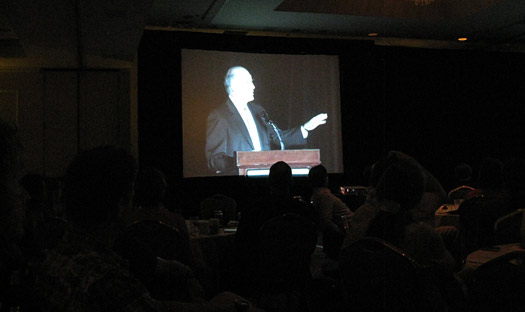Ah yes, Grasshopper, we have entered the temple and are bowing at the feet of the fleece. Indeed, I’ve seen some cool stuff and shall blog a few choice tidbits for your edification. Soon.

Salazar on the big screen for a big crowd. He looked better than my photo. Sorry Ken.
But, after the past months of economic fears, I have to admit I’m a heck of a lot more interested in what makes all this tick; more interested than I am in trying to play textile engineer and figure out what type of unobtanium the latest jackets are made of.
To that end, this morning Lisa and I attended the annual Outdoor Industry Association breakfast event to hear a speech by Interior Secretary Ken Salazar. Later we met with Black Diamond chief Peter Metcalf for his take on where BD is going now that they’ve transitioned to being publicly traded. (More about our conversation with Peter to be published in a later post.)
Back when everything in America was humming smoothly along, the breakfast speech would have probably been laced with downer references to the demise of the planet and how recycling water bottles would save us.
Instead, the ambitious environmental stance of the Obama administration filtered down through speeches by Nancy Sutley of the Council on Environmental Quality, and (keynote) by Secretary of the Interior Ken Salizar. I don’t write that to be cynical, as I’m a big fan of just about anything that truly helps sustain our natural environment, be it a city park or a wild river. (Full disclosure: For those of you who know we’re not the most PC blog around, perhaps we’re a tiny bit cynical…).
Perhaps amongst certain circles optimism is keynote of crumby economic times. As Salizar pointed out, look back at history and be stunned by how many important environmental actions took place during times of national stress. He ticked off a bunch of examples, one being the founding of Yosemite National Park during the Civil War. Hmmm, that sounded like a bit of reach so I looked it up.
Okay, Yosemite was actually founded in a conventional sense in 1890, but I’ll concede it looks like the park was indeed beginning as a concept in the early 1860s so I’ll give Salazar that (though he might want to have a little conversation with his speech writer.)
What I liked best about Salazar’s take was he didn’t shy away from emphatically emphasizing that the outdoor industry in the U.S. creates a 730 billion dollar flow of money in the economy, along with six and a half million jobs.
To me, conservation has to be tied tied to economics. Sure, we’d like to value the natural world on its own merits, but reality in our capitalist system is that unless money is associated with something, it tends to get neglected. (And of course, that something might get mistreated anyway, especially up through recent history or even at present, witness the BP oil spill).
Another thing I liked about Salazar and Sutley was they erected a big tent in their talk that included just about all outdoor recreation. This in the face of a mostly muscle powered crowd. That’s probably to be expected as politicians can’t risk excluding people, but nice to hear anyway as our whole approach to public land use here at WildSnow.com is that there’s plenty to go around and most forms of outdoor recreation are pretty darned legit no mater what the power source.
So what’s exciting about all this is that the outdoor recreation industry, I repeat, outdoor recreation, is big and getting bigger while much other stuff is shrinking. Proof, here at Outdoor Retailer the show is sold out and hotel bookings are up 20 percent.
Thinking it through, consider that Outdoor Retailer is not a boat show, and not an ATV show. That’s some stunning growth in a sector that’s mostly muscle powered.
Read that and weep if you’re an anti growth iconoclast. But what would you rather have, 20% growth in the outdoor recreation industry, or 20% in coal mining to provide electricity to couch surfers?
Next, we meet with Metcalf for his take on Black Diamond. Oh, and we’ll blog soon about a few temple ornaments (otherwise known as gear).
WildSnow.com publisher emeritus and founder Lou (Louis Dawson) has a 50+ years career in climbing, backcountry skiing and ski mountaineering. He was the first person in history to ski down all 54 Colorado 14,000-foot peaks, has authored numerous books about about backcountry skiing, and has skied from the summit of Denali in Alaska, North America’s highest mountain.
